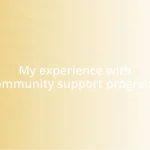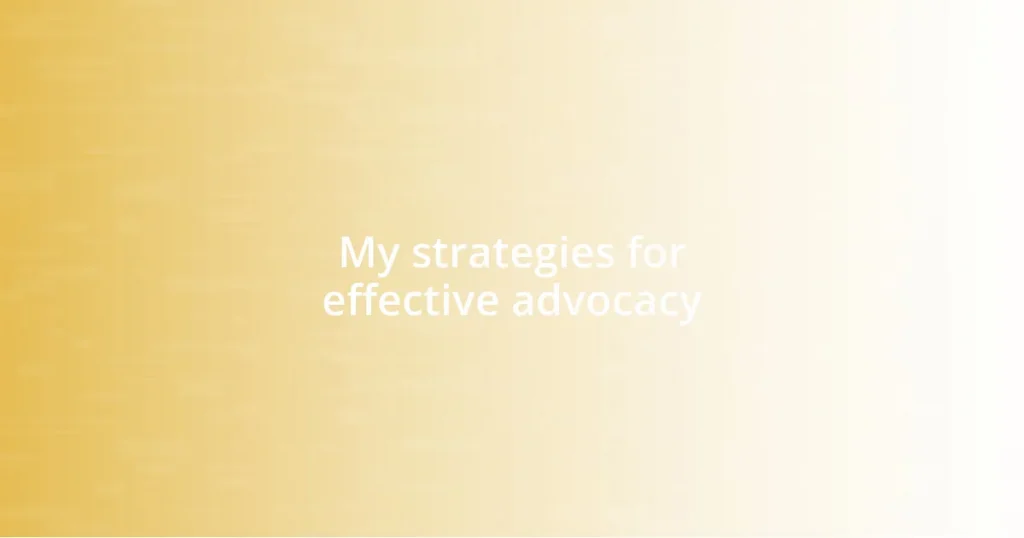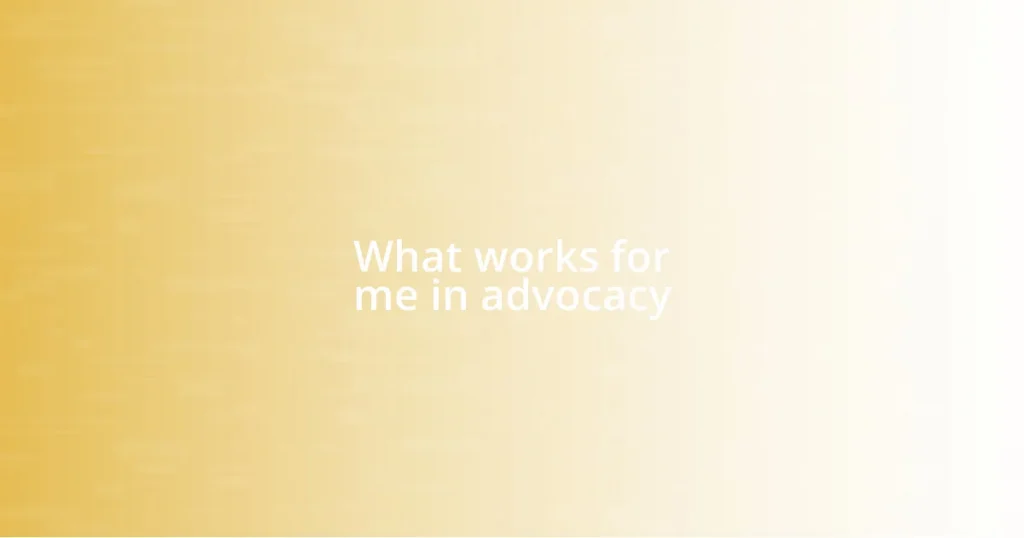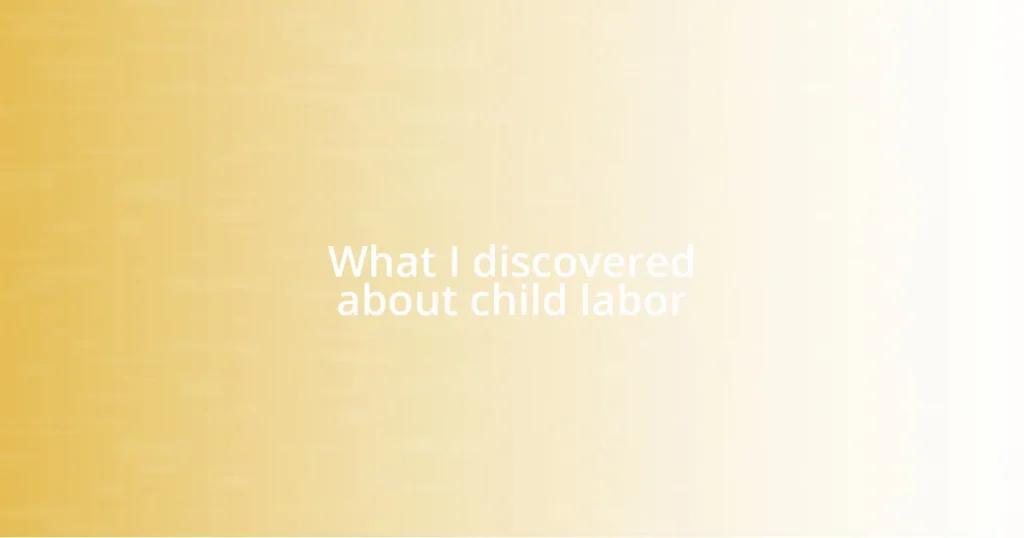Key takeaways:
- Effective advocacy relies on understanding the needs of the audience and framing messages to resonate emotionally.
- Setting specific, measurable advocacy goals drives action and motivation for both individuals and teams.
- Identifying demographic and psychographic characteristics of the target audience enhances the relevancy of advocacy messaging.
- Building and maintaining strategic partnerships amplifies advocacy efforts through shared strengths and collaboration.

Understanding advocacy fundamentals
Advocacy is more than just speaking up; it’s about understanding the needs of the people you represent. Personally, I’ve seen how powerful it can be when you truly listen to someone’s story before diving into action. Have you ever had a moment where you realized that the biggest impact often comes from empathy rather than just facts?
At its core, effective advocacy hinges on clear communication. I remember an event where I struggled to convey a critical message; it was a turning point for me. Noticing the confusion in the audience made me ask myself: How can I express my thoughts in a way that truly resonates with my listeners? This realization highlighted the necessity of framing our messages to ensure they connect emotionally and intellectually.
Understanding your audience plays a crucial role in advocacy. I often reflect on how each person brings their own experiences and perspectives to the table. Have you considered how your unique background influences your advocacy approach? By acknowledging this, we can tailor our strategies to build stronger bridges, ensuring that our voices represent the diverse needs of the community we aim to support.

Developing your advocacy goals
Developing your advocacy goals requires both introspection and clarity. I’ve often found myself at a crossroads, unsure of how to navigate my ambitions. One memorable moment was when I had the chance to lead a campaign for a local environmental initiative. It taught me the importance of setting specific, measurable goals. Having these goals not only guided my actions but also motivated my team to rally behind a clear vision.
To effectively develop your advocacy goals, consider the following steps:
– Identify the specific issues you are passionate about.
– Reflect on what success looks like for you and the community.
– Break your goals down into short-term and long-term objectives.
– Engage your audience to explore what they want to see change.
– Stay flexible and willing to adjust your goals based on feedback and outcomes.

Identifying your target audience
Identifying your target audience is essential for effective advocacy. I recall a time when I was working on a social issue, and I assumed I understood exactly who needed to hear my message. However, I quickly realized that the nuances of the audience’s experiences were far more complex than I anticipated. By taking the time to engage with diverse community members, I found that their specific concerns and values shaped how I should communicate my advocacy. Have you ever had similar realizations in your journey?
When I think about identifying my target audience, I emphasize the importance of demographics and psychographics. Demographics can include age, gender, and socioeconomic status, whereas psychographics delve into beliefs, values, and lifestyle choices. A few years ago, I addressed a community group focused on youth mental health. By understanding both their demographic background and the psychographic drivers behind their struggles, I was able to craft messages that truly resonated. What factors do you think would shape your target audience’s perspective?
To effectively identify your target audience, you should consider various methods of engagement, such as surveys, interviews, or focus groups. I often use social media polls to gauge opinions and preferences, as this provides instant feedback and insight. It’s fascinating how accessible these tools are and how they can alter our approach to advocacy. What strategies have you found helpful in connecting with your audience?
| Aspect | Demographic | Psychographic |
|---|---|---|
| Examples | Age, Gender, Income | Values, Beliefs, Interests |
| Impact on Advocacy | Shapes the message format | Influences the message content |

Crafting persuasive messages
Crafting persuasive messages is an art that combines clarity and emotive language. I remember a time when I was drafting a speech for a community rally on renewable energy. The more personal stories I included—like how a local family struggled with high utility bills—the more engaged my audience became. Have you noticed how a relatable story can make a complex issue feel more approachable?
Understanding the core message you want to convey is crucial. I often start by identifying the key takeaway I want the audience to remember. For instance, during a campaign for accessible healthcare, I focused on a single statistic that highlighted the crucial gap in services. By tying that number to a real-life example, I was able to make the message more impactful. What key points do you think resonate most with your audience?
Additionally, language can significantly shape how your message is perceived. In my experience, using inclusive, positive language fosters a sense of community and shared purpose. I’ve found that phrases like “together we can” can motivate action much more effectively than more directive language. Have you experimented with different word choices in your messages? You might be surprised at the difference it can make in your advocacy outcomes.

Building strategic partnerships
Building strategic partnerships is pivotal for amplifying the impact of any advocacy effort. I recall my experience collaborating with a local environmental group. We each brought unique expertise to the table: while I focused on community outreach, they offered vital insights on environmental science. This collaboration transformed our campaign, illustrating how combining strengths can lead to deeper engagement and broader reach. Have you ever teamed up with others for a cause that revitalized your own efforts?
Forming partnerships requires deliberate effort and mutual respect. I remember attending a community forum where I met representatives from various organizations. Instead of merely exchanging business cards, we engaged in meaningful discussions about our shared goals. The connections made that day resulted in joint events and campaigns that would’ve been impossible individually. Have you considered how a single conversation can open the door to a world of possibilities in your advocacy?
It’s important to cultivate these partnerships continually. I’ve learned that maintaining relationships is as crucial as building them. Regular check-ins, collaborative brainstorming sessions, and shared successes can nurture these connections. For instance, after initiating a health awareness initiative with a nearby school, we established a periodic review meeting to assess our progress and strategize next steps. This consistent communication bolstered our commitment and strengthened our impact. How do you keep your partnerships thriving and productive?

Leveraging social media tools
Leveraging social media tools can dramatically expand the reach of an advocacy message. I recall launching a campaign via Twitter to raise awareness for mental health resources. The swift interaction with followers—sharing their stories and using relevant hashtags—created a community that not only engaged with the content but also shared it, leading to conversations beyond our immediate circle. Isn’t it incredible how a simple tweet can ignite widespread dialogue?
Creating visually appealing content is essential on platforms like Instagram. I’ve found that a well-designed infographic can convey complex information at a glance, making it easier for people to grasp important issues. For instance, during my campaign on environmental conservation, I shared striking before-and-after photos to illustrate the impact of pollution. The visual aspect sparked discussions, and viewers seemed more willing to share what they learned. Have you experienced the power of visuals in enhancing your advocacy efforts?
Interacting directly with your audience is a game-changer. When I went live on Facebook to discuss legislation impacting our community, I was surprised by how many questions flowed in. This immediate feedback loop allowed me to address concerns in real-time and adjust my messaging accordingly. It felt like having a conversation with a close friend rather than delivering a one-sided speech. How do you incorporate direct dialogue into your social media strategy to make your advocacy more relatable?

Evaluating advocacy impact
Evaluating the impact of advocacy efforts is an essential step that allows us to understand what truly resonates with our audience. After one campaign aimed at promoting literacy in marginalized communities, I took the time to gather feedback through surveys and informal conversations. It was eye-opening to see how our initiatives affected participants and helped them discover resources they never knew existed. Have you ever felt that surge of pride knowing your efforts made a tangible difference in someone’s life?
Another vital aspect is setting measurable goals from the outset. During my advocacy for affordable housing, I implemented a system to track our progress against specific targets, like community engagement and policy changes achieved. When I reviewed these metrics later, I felt a mix of excitement and motivation, realizing how close we were to influencing real change. How do you quantify success in your advocacy journey, and do these metrics inspire you to keep pushing forward?
Lastly, reflection plays a key role in evaluating impact. One of my most memorable experiences was hosting a debrief after our campaign on sustainable practices, where team members shared what they learned. This not only highlighted areas for improvement but also celebrated our achievements, which ultimately fostered a stronger sense of community among us. How do you ensure that insights gathered from a project contribute to your future advocacy initiatives?















